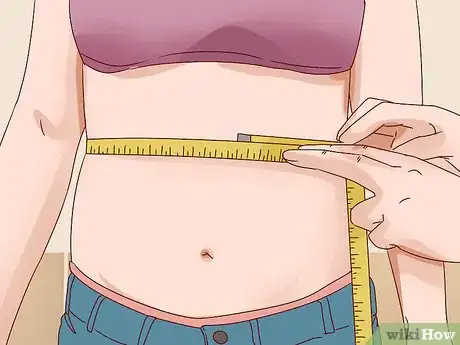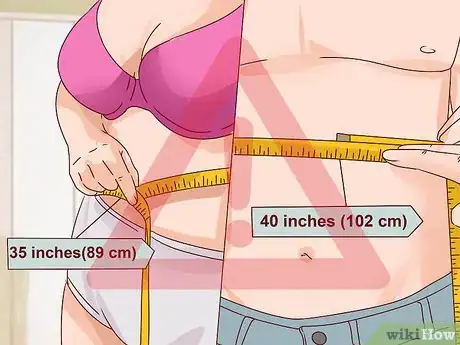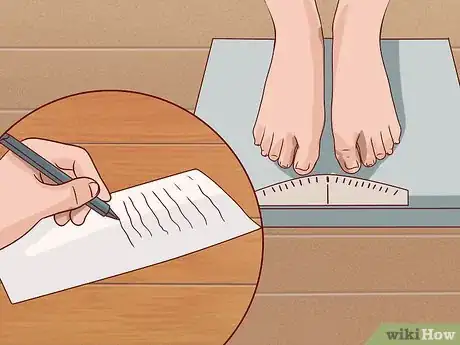This article was co-authored by Jourdan Evans, DPT. Jourdan Evans is an ACE (American Council on Exercise) certified Personal Trainer based in Los Angeles, California. She received her DPT in Physical Therapy from St. Ambrose University in 2012 and received her ACE certification in 2013.
This article has been viewed 127,472 times.
Tracking your body fat percentage over time is one of the best ways to plot your fitness or weight loss progress. Skin-fold calipers are one of the most cost-effective and accurate ways of tracking changes in body fat, but only in the hands of a skilled tester. You can't perform skinfold caliper tests on yourself, so if you're trying to measure your body fat alone, don't have a pair of calipers or don't have the proper training to use them, you have your choice of alternative methods.
Steps
-
1Measure your height. Don't wear shoes, and stand tall.
-
2Measure your waist. For women, measure the circumference of your waist at the level with the least width, where it narrows or "pinches" in. For men, measure the circumference of your waist at a horizontal level around the navel. Don't pull your stomach in.Advertisement
-
3Measure your neck circumference. Place your tape below the larynx and sloping slightly downward to the front. Avoid flaring your neck out or flexing your neck.
-
4Measure your hips, if you're a woman. Measure the circumference of the hips at the largest horizontal measure.
-
5Plug the numbers into one of the formulas below, or use an online calculator. Round your answer to the nearest full percent.[1]
- Formula for men, inches: %Fat = 86.010*LOG(abdomen - neck) - 70.041*LOG(height) + 36.76
- Formula for men, centimeters: %Fat = 86.010*LOG(abdomen - neck) - 70.041*LOG(height) + 30.30
- Formula for women, inches: %Fat = 163.205*LOG(abdomen + hip - neck) - 97.684*LOG(height) - 78.387
- Formula for women, centimeters: %Fat = 163.205*LOG(abdomen + hip - neck) - 97.684*LOG(height) - 104.912
Measuring Your Waist Circumference
-
1Strip down to your underwear or a swimsuit. Ideally, you should measure over your bare skin, but you can wear a thin shirt if necessary. To maintain consistency, wear the same clothing every time you measure. [2]
-
2Measure your waist. Wrap a flexible measuring tape around your waist, just above the crest of your hip bones. The measuring tape should feel snug and flat against your skin, but not so tight that it is uncomfortable.[3]
- You may need a mirror to make sure the measuring tape is level and lies flat against your skin.
- Measure in the same location every time, and try to use the same measuring tape.
-
3Check for health hazards. Waist circumference measurement doesn't tell you your exact percentage of body fat, but it does gives you useful relative measurements.[4]
- Non-pregnant women whose waist circumference is >35 inches (89 cm), and men whose waist circumference is >40 inches (102 cm), are at increased risk of developing obesity-related conditions such as hypertension and adult-onset diabetes.
- If you are not expecting to be pregnant nor gaining weight, and your waist circumference is growing, contact your doctor. You may be pregnant or experiencing a medical issue.
Calculating Your Body Mass Index (BMI)
-
1Measure your height. Don't wear shoes, and stand tall.[5]
-
2Measure your weight. Stand on a scale that has been calibrated and get your weight in pounds or kilograms.[6]
-
3Compare to a BMI table. Once you find a credible BMI table, locate where your height and weight measurements intersect. The number listed at the intersection is your BMI, or your body mass index.[7]
- Get an online BMI table here.
- Our BMI tends to naturally rise slightly as we age.
- Children and Teen BMI readings: you must calculate the child's BMI using an age- and gender-appropriate table. Otherwise, the results will be inaccurate.
- You can also use an online calculator to calculate BMI. Click for adult and teen - child calculators.
-
4Understand your BMI rating. Your BMI is a ratio of your body height and weight, your “mass.” Your body is made of fat, bones, blood, muscle, and many other tissues that contribute to your weight, and your BMI. Your BMI rating does not directly correlate to your percentage of body fat, but is a way to monitor your size.[8] Below are listed ranges for medical weight classes for adults. A BMI value of
- <18.5 is underweight.
- 18.5 – 24.9 is in the "normal" range.
- 25 – 29.9 is overweight.
- >30 is considered obese.[9]
- A number of extremely muscular, not fat, individuals fall in the overweight category because their muscle weighs so much. Talk to your doctor about what your BMI means for you.
- If you are not exercising and growing muscle mass but are gaining weight, it is likely that weight is fat.
- If you are exercising and eating healthily, while gaining weight, it is possible that weight is muscle and only partially fat.
- If you are losing weight, you are probably losing both muscle and fat.
Warnings
- For men: your body fat percentage should never be below 8. If your body fat is 8% or less of your body composition, contact a doctor or hospital.[11]⧼thumbs_response⧽
- For women: your body fat percentage should never be below 14. If your body fat is 14% or less of your body composition, contact a doctor or hospital.[12]⧼thumbs_response⧽
- When in doubt, contact your primary care physician, dietician, nutritionist, trainer, therapist, or other medical professional.⧼thumbs_response⧽
Things You'll Need
- Flexible measuring tape
- Notebook
- BMI table or Internet (optional)
- Calculator (optional)
References
- ↑ https://www.calculator.net/body-fat-calculator.html
- ↑ http://www.hsph.harvard.edu/obesity-prevention-source/obesity-definition/how-to-measure-body-fatness/#waist-circumference
- ↑ http://www.hsph.harvard.edu/obesity-prevention-source/obesity-definition/how-to-measure-body-fatness/#waist-circumference
- ↑ http://www.hsph.harvard.edu/obesity-prevention-source/obesity-definition/how-to-measure-body-fatness/#waist-circumference
- ↑ http://www.hsph.harvard.edu/obesity-prevention-source/obesity-definition/how-to-measure-body-fatness/#waist-circumference
- ↑ http://www.hsph.harvard.edu/obesity-prevention-source/obesity-definition/how-to-measure-body-fatness/#waist-circumference
- ↑ http://www.hsph.harvard.edu/obesity-prevention-source/obesity-definition/how-to-measure-body-fatness/#waist-circumference
- ↑ http://www.hsph.harvard.edu/obesity-prevention-source/obesity-definition/how-to-measure-body-fatness/#waist-circumference
- ↑ http://www.hsph.harvard.edu/obesity-prevention-source/obesity-definition/how-to-measure-body-fatness/#waist-circumference

















-Step-14-Version-3.webp)





















































